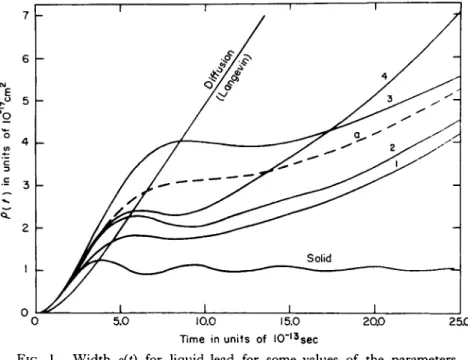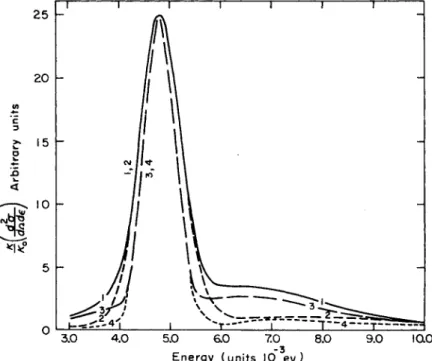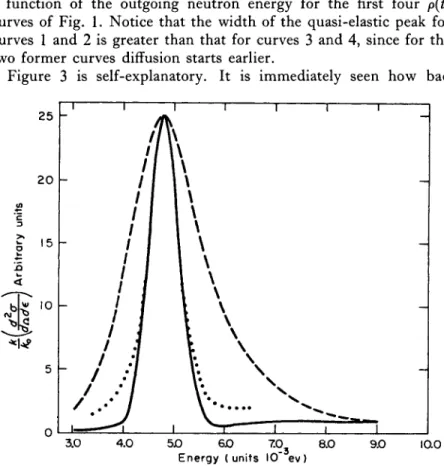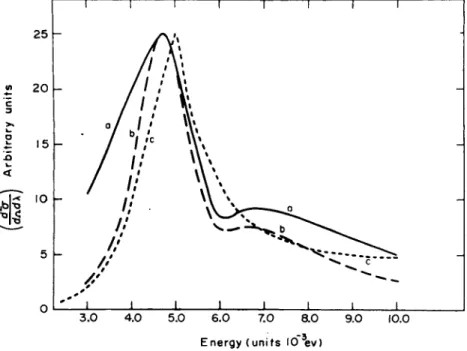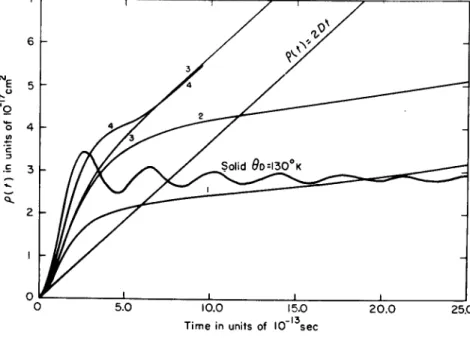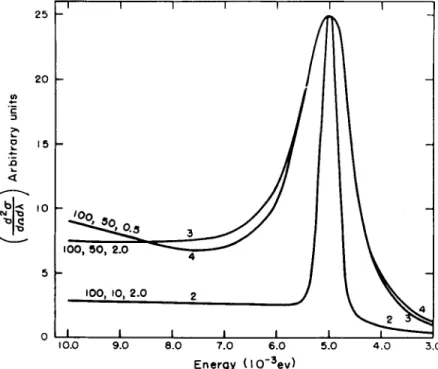Neutron Scattering
K. S. S I N G W I *
Argonne National Laboratory, Argonne, Illinois
N e u t r on spectroscopy has proved to be an extremely powerful tool in the study of the dynamics of atomic motions in solids ; for exam- ple, we now know the exact form of the frequency spectra of some solids, and the dispersion relation, and we probably know, in some solids, the magnitude of the p h o n on lifetime at high t e m p e r a t u r e s. Near the melting point of a solid, it is rather doubtful to talk of the p h o n on lifetime since it becomes, as the neutron experiments have shown, of the same order as the period of the motion of an atom.
Al l this knowledge is of fundamental importance and has confirmed that our basic ideas about lattice dynamics are essentially correct.
I t is only very recently that cold neutron scattering work in liquids has begun. T he work discussed here has, for the most part, been inspired by the experimental work of the Chalk River group, the Brookhaven group, and the Swedish group. Interpretation of exper- imental work is m u ch more difficul t in liquids because there does not exist even a bad theory. Atomic motions in a liqui d are very complex; one does not have a simple harmonic motion lik e that in a solid. No attempt wil l be made here to give any theory of the liqui d state since this writer does not know of one, b ut some interpretation wil l be given of the available experimental results on neutron scattering in liquids on the basis of what one might call physically plausible models of a liquid. H ow good a model is wil l be d e t e r m i n ed ultimately by the results it yields.
One very characteristic feature of the scattered neutron energy spectra in liquids, which was brought out in the last two or three figures of Dr. Brockhouse's discussion, is that there is a narrow quasi-elastic peak, sitting nicely on an almost flat scattering back- ground, the latter corresponding to inelastic scattering. T h is broad observation indicates that there are two time scales as far as the motion of an atom in a liquid is concerned; one a short-time scale and another a long-time scale. On the short-time scale the behavior
* Present address: University of Allahabad, Allahabad, India.
145
of an atom in a liqui d is very m u ch lik e its behavior in a gas. But on the long-time scale the atom stays in its locality for some time ( ~ 1 0 ~12 sec), where it makes a very complicated vibratory motion and then j u m ps to the next position. T h is is of course a very simpli- fied picture which is not entirely correct, because there are small motions too. T h is sedentary lifetime of an atom is a very important feature in the sense that it helps one to understand that a liquid is capable of both rigidity as well as its characteristic fluidity. If we apply a varying stress to a liqui d and if its period is smaller than the sedentary lifetime, the liqui d would exhibit rigidity or elasticity lik e a solid; whereas if the period is greater, the liquid would relax and would exhibit its characteristic fluidity. T h is concept was earlier introduced by F r e n k e l1 and we do get supporting evidence from neutron scattering experiments. I n fact, the well-known Maxwell relation, τ — η/μ, connecting the relaxation time τ wit h the viscosity η and the modulus of rigidity μ of a liqui d then becomes easily understandable.
T he incoherent differential scattering cross section per atom per unit solid angle Ω and per unit energy transfer %ω is given by the following formula which is due to Van H o v e2:
- a f c =β2 ΐ à iZ i Z e x* 'p r ~W ω ί ) ] ( ? 8 ( Γ· t ) d r d t> ( 1) where the m o m e n t um transfer is %Y. — %(k0 — k), and the energy
transfer is %ω = (%2l2m) (k02 — k2). T he self-diffusion function Gs(r, t) gives the probability of finding an atom at a distance r at time t if it was at the origin at time t = 0. T he other symbols i n (1) have their usual meaning. I t is not surprising that such an equation as (1) (with Gs replaced by G) should exist, since we know that in x-ray scattering the differential scattering cross section is given by the space transform of the instantaneous pair correlation function ^(r) ; and since in the neutron case we are taking into account the energy changes on scattering, it is quite natural that the scattering is expressed as the four-dimensional Fourier transform of a function G(r, i) which is an obvious extension of the g(r) function. I n what follows we shall be mainly concerned wit h the self-part of the G-function i.e., Gs(r, t). It has so far not been possible to solve the many-body problem, and, therefore, to compute Gs(r, i) rigorously.
Nevertheless, the great advantage of Van Hove's formalism is that
one can get some information about it from physical considerations. For example, if for this Gs-function one inserts in Eq. (1), let us say, the solution of the simple diffusion equation wit h which we are familiar—a Gaussian function wit h a time-dependent width equal to 2Dt, where D is the well-known diffusion coefficient, one gets after carrying out the trivial integration the following:
d2a _ α*> _Λ k2D
dQdw ~ V k 0 (k2D)2 + ω2 ' V*
T he broadening Ae of the quasi-elastic peak is given by
Ae = 2Hk2D. (3)
T h u s, knowing the width, the scattering angle, and the incident wavelength of the neutron, one can determine the diffusion coeffi- cient, or conversely, knowing the latter one can determine the width.
I t is found that the theoretical width given by (3) is m u ch larger than the experimental w i d t h; this is the first point. T he second point is that the observed scattering is not correctly given by Eq. (2), nor does E q. (2), contain a structure factor of the D e b y e- Waller type which has been observed experimentally. F u r t h e r m o r e, Palevsky, in the case of liquid lead and tin, has measured the temperature dependence of this width, and by plotting the logarithm of this width as a function of the inverse temperature, he gets an activation energy which is almost half of the activation energy obtained from the conventional diffusion coefficient measurement. Al l these facts together tell us that the motion of an atom in a liqui d is not so simple that it can be described by the usual diffusion equation. T h is one should expect because such an equation holds for long times and large distances, whereas in neutron scattering long times do not play an important role. I n fact, it turns out that for neutron wavelength and scattering angles of interest, almost 9 5% of the contribution to the integral in (1) comes from the time range 0 to 1 0- 11 sec, for which the simple diffusion equation is, obviously, a very poor approximation.
W e shall now consider another extreme case in which the diffusive motion of an atom in a liquid is very similar to that i n a solid ; that is where it describes a complicated localized motion something similar to that in a solid, though highly anharmonic, and t h en j u m ps to the next position and so on. On the basis of such a jump-diffusive model
Singwi a nd Sjolander3 have calculated t he scattering cross section i n t he case of water. T he results of this calculation are t he following:
T he full width at half-maximum of t he quasi-elastic peak is given by
AE = — 1 Γ Ί —T n , ( 4 )
τ0 L 1 + k2Dt0 J
where r 0 is the time for which an atom stays in its locality before making a j u mp a nd 2W is t he Debye-Waller factor for water con- sidered as a Debye solid. I n t he case K2DT0 <^ 1, E q. (4) reduces to (1); a nd i n t he case K2DT0^> 1, Ae ~ 2^/r0. T h us we see that for large values of t he scattering angle t he width shows a saturation effect. A recent experiment of Larsson and D a h l b o r g4 does show such a saturation trend for t he width. D r. Brockhouse has stated that his experimental points do not show such a trend, b ut i n any case they li e i n t he intermediate region, i.e., between t he curve given by t he simple diffusion theory a nd that given by o ur jump-diffusion model. W e shall have to wait for more experimental results before we are able to pass a j u d g e m e nt on this model. T h e re is no doubt that this model does predict a structure factor (e~2W) i n t he scattering as is found experimentally. T he value of τ 0 that we find in the case of water is approximately 4 X 1 0 ~12 sec; this value is consistent wit h other independent experimental evidence such as t he structural relaxation time for excess ultrasonic absorption.
T he jump-diffusion model is probably a reasonable one for water, which is a highly b o n d ed liquid. But what about liqui d argon or liqui d lead where there is no such strong hydrogen bonding ? I n such open liquids one might cast doubts on a model of this type.
I t is my guess that even i n such open liquids there would exist a time τ 0, whose value would, no doubt, be smaller than that for water, but m u ch greater than t he value of t he period for atomic vibration.
T he t r ue diffusive motion of an atom in a liquid must indeed be a mixture of small a nd large motions ; it is t he latter which predominate i n a bonded liqui d lik e water.
W e shall n ow examine a slightly different formulation of t he scattering cross section. I t has been shown by R a h m an et al.5 that the incoherent differential scattering cross section can be written as
= À £
e ^ B T [+°° e-t*t e x pr - **p(t)l2]dt, (5)ai, J α ω Ζπη R0 J - O O
where p(t) is given by
4MkRr
I n Eq. (6) the expression <U(0) · U(u))T represents the statistical and q u a n t um mechanical average of the velocity correlation function.
Equation (5) is based on the assumption of a Gaussian approximation for the Gs( r , t) function. T he non-Gaussian part of Gs( r , t) which corresponds to taking higher velocity correlations into account has been neglected. I t is our conjecture that the n o n - G a u s s i an correction is small.
I n the expression for p(t), the first t e rm is purely q u a n t um mechani- cal in origin and corresponds to the finite extension of the thermal cloud at t = 0. I n the computations which we have made, we have used the classical velocity correlation function in place of Re <U(0) · U(w)>T, since q u a n t um corrections of order %2 have consistently been neglected. For all classical liquids this is a very good approximation.
For the classical velocity correlation function we have assumed the following:
T he frequency ωΌ introduced here corresponds to the D e b ye fre- quency in a solid. T he d a m p i ng factor e~yi in the first t e rm has been introduced to d a mp the characteristic oscillatory behavior of p(t) i n a solid. T he second t e rm in (7) corresponds to the velocity cor- relation for a diffusing atom obeying Langevin's equation except that the factor (1 — e~*1) has been introduced to delay the diffusion.
T he parameters α and β are related to the diffusion coefficient D t h r o u gh the relation
< u ( 0 ) . u w >r = ^j 9kBT d
MœD2 dt
sincu£>i wDt
DM (8)
β(« + β) '
T he width function p(t) as c o m p u t ed wit h the help of (6) and (7) has the correct limitin g form both for large and small values of the time t. By varying the parameters, p(t) can be made to assume, for
intermediate values of time, various forms lying between those for a solid a nd for a diffusing atom.
Some of t he results of t he computations based on t he model just described are shown i n t he figures. Figure 1 shows p(t) for liqui d
Time in units of IO",3sec
FIG. 1. Width p(t) for liquid lead for some values of the parameters, and also for solid lead and for a diffusing atom.
Parameters
Curve T(°K)
D χ 10δ (cm2 s e c- 1)
Ύ/ωΏ oi/a>D
1 2 3 4 a
620 620 620 620 735
60 60 40 60 40
3.0 3.0 3.0 3.0 4.5
0.25 0.125 0.25 0.125 0.5
0.005 0.005 0.005 0.015 0.005
lead, plotted as a function of time for various values of the parameters shown. Also shown are t he t wo extreme cases: (a) simple diffusion and (b) solid. Notice that curve 4, which corresponds to a relatively
large value of a, rises m u ch more quickly than do curves 1, 2, and 3 for which α is small. Small values of α correspond to delayed diffusion. Al s notice that curves 1 and 3 oscillate less than curves 2 and 4, since in the former the value of the damping parameter y is large. T he more pronounced the oscillations in the p(t) curve, t he more is the structure expected in the Fourier transform.
Figure 2 shows the differential scattering cross section plotted as τ 1 1 1 1 r
3.0 4.0 5.0 6.0 7.0 8.0 9.0 IQO E n e r g y ( units 10 ev ) - 3
FIG. 2. Differential scattering cross section ( X k/k0) versus outgoing neutron energy for neutrons of incident energy 4.8 X 10~3 ev scattered at 90° by liquid lead at 620°K. Values of the parameters are as shown.
Parameters
Curve Θ - "D ck) N
y\oiD
1 40 0.25 0.015
2 60 0.25 0.015
3 40 0.25 0.005
4 60 0.25 0.005
a function of the outgoing neutron energy for the first four p(t) curves of Fig. 1. Notice that the width of the quasi-elastic peak for curves 1 and 2 is greater than that for curves 3 and 4, since for the two former curves diffusion starts earlier.
Figure 3 is self-explanatory. I t is immediately seen how bad
FIG. 3. Differential scattering cross section ( x k/k0) versus outgoing neutron energy for neutrons of incident energy 4.8 X 1 0-3 ev scattered at 90°K by liquid lead at 620°K. Computed and observed curves have been compared. — , Diffusion (Langevin); half-width, 8 X 10~4 ev. p a r a - meters as in curve 1, Fig. 1; half-width, 3.5 X 10~4 ev. Experimental (Brockhouse); half-width, 3.5 X 10"4 ev.
the simple diffusion theory is. I t gives a half-width of the quasi- elastic peak which is more t h an double what Brockhouse and P o p e6 have observed. T h e ir experimental results are well represented by the parameters of curve 1 of Fig. 1. T he ordinates in Figs. 2 and 3 have a factor k/k0 because we have followed the whims of the experimenters.
Since Palevsky7 used a beryllium-filtered neutron beam in his
experiments, we have integrated our calculated cross section for parameters of curve a of Fig. 1 over the incident spectrum and the results are shown in Fig. 4. T he agreement is fairly good. T he results based on the simple diffusion theory, are not presented here but they show no semblance of agreement wit h the experimental curve. Experiments using a filtered beam of neutrons, despite a very sharp cutoff, are less suitable for the study of the dynamics of atomic
8.0 E n e r g y ( units 10 3ev)
9.0 10.0
FIG. 4. Differential scattering cross section versus outgoing neutron energy for Be-filtered neutrons scattered at 90° by liquid lead at 735°K.
Values of the parameters are as shown. T h e coherent correction (1 + Γ(κ)) is according to Vineyard's [Phys. Rev. 110, 999 (1958)] convolution approxi- mation.
Parameters
Curve T(°K) D - ° (°K)η Dω x 1 05
ks (cm2 s e c- 1) ΎΙ°>Ό oc/a>D 1 + Γ(κ)
a b c
735 735 Experimental
40 4.5 40 4.5 (Palevsky)
0.5 0.5
0.005 0.005
Without With
motions in liquids. T he reason is that the broad incident spectrum has the tendency to give a spurious structure (as a result of integra- tion) in the inelastic scattering and to make the interpretation of even the quasi-elastic scattering somewhat ambiguous. I t is suggested that experiments should, therefore, be performed wit h m o n o- chromatic beams of cold neutrons (λ ^ 4 A).
We were quite satisfied wit h our success in liquid lead. But when this model was applied to liqui d water, we were somewhat disappointed.
Wit h a certain choice of the parameters, we could either fit the quasi- elastic scattering or the inelastic scattering (arising from the trans- lational motion alone) but not both. We then started looking for a better model.
T he model that wil l now be described was developed in collabora- tion wit h R a h m an and Sjolander.8 We shall call it the stochastic model. I t is based on the conception that the heat motion of atoms in a liquid is very similar to that in a solid. I t is, of course, understood that proper account wil l have to be taken of the damping of the vibra- tions and of the self-diffusive motion of an atom in a liquid.
W e assume that the displacement of an atom in a liqui d can be considered as a superposition of statistically independent components each of which obeys a Langevin-type equation of motion:
+ β3 *£± + = Fit), (9)
where β8 is the damping constant and Fs(t) is the stochastic force for the mode s. T he solution of this equation has been discussed in detail by Chandrasekhar9 and by W a ng and U h l e n b e c k .10 Obviously, such an equation would not lead to any diffusion since the mean position of each oscillator is never displaced. For the purpose of building into this picture a mechanism for diffusion, we remark that low frequency transverse modes cannot propogate in a liqui d and should necessarily degenerate into a diffusive type of motion. T h is is not true for longitudinal modes. As an approximation, we assume that all vibrations including longitudinal and having a frequency below a certain frequency ω have no restoring force. T h u s, for ω8 < α/, Eq. (9) reduces to
dHsdt
+β.-¥τ = η*), (ίο)
2 1 rs dtwhich, as we know, is Langevin's equation for diffusive motion
W e shall assume that the law of frequency distribution of the modes is of the Debye type wit h a certain upper limi t œD. We have, there- fore, two parameters ω ' and wD in the model. As regards β8 for the diffusive modes, we have put it equal to a constant β , and for a vibratory mode we have taken β8 to be proportional to ω8. T he latter assumption is based on the fact that in a solid the d a m p i ng of t he high frequency modes is roughly proportional to their frequency.
W e t h us have in the m o d el two more parameters, β and a constant of proportionality y, which we call the d a m p i ng parameter. T he diffusion coefficient D can be expressed in t e r ms of ω ' , ωΏ, and β . Hence, effectively, we have three parameters at our disposal in this model.
I t is easy to see how these parameters wil l participate in producing the diffusion constant D. I n the absence of all vibratory modes, i.e., ω ' — œD, we know that
M being the mass of the atom and Τ the temperature of the system.
W i t h ( ω ' / ωà)3 modes participating in diffusion, we find that D is given by
I n this model the value of β is m u ch smaller t h an
k
BTjMD,
and this leads to a delay in the setting in of the diffusive behavior of an atom i n a liquid.A s mentioned earlier, there exists in the literature a solution of Eq. (9) ; hence, it is an easy matter to calculate the velocity correlation
<U(0) · \J{u)YT for each m o de and t h en integrate it over the Debye frequency distribution, keeping in m i nd that for ω8 < ω ' it is Eq. (10) that we have to consider, and for ω8 ^ ω ' it is Eq (9).
K n o w i ng the velocity correlation, we can calculate the width function p(t) from Eq. (6), and then the scattering cross section from (5). T he results of our computations for water are described briefly.
Figure 5 shows p(t) plotted as a function of time for the values of the parameters shown. Γ is related to the damping para- meter γ. T he parameters ω ' and œD are, respectively, expressed as temperatures θ' and ΘΌ t h r o u gh the relation %ω — kB0. Notice that i n curves 1 and 2, the asymptotic behavior of p(t), i.e., p(t) — 2Dt,
D = kT/Μβ , ( Ð )
(12)
is not yet attained; this is because of the small value of θ\ i.e., of the smaller n u m b er of diffusive modes. Curves 3 and 4 for which
& is comparatively large have quickly attained the asymptotic limit . Also notice that in curves 1, 2, and 3 there are no oscillations because
FIG. 5 . Width function p(t) for water for some values of the parameters;
p(t) for a solid (dD = 1 3 0 ° K ) and that obtained from the diffusion equation is also shown. Temperature, 3 0 0 ° K ; mass, 1 8 a.u.; D = 1 . 8 5 X 1 0 ~
5
cm2/sec.Parameters
Curve θ' Γ
1 1 3 5 1 3 . 5 2 . 0
2 1 0 0 1 0 2 . 0
3 1 0 0 5 0 2 . 0
4 1 0 0 5 0 0 . 5
of the large damping. On the other hand, curve 4 for which the value of Γ is comparatively small has a littl e oscillatory behavior.
W e have found that a value of Γ (in dimensionless units) greater than 2 does not produce in the curves any further change. T he
characteristic feature of curves 1 a nd 2 is a thermal cloud, which after a rapid initial rise, develops almost linearly for a considerable length of time b ut wit h a very small slope. T h is rate of increase of the width of the thermal cloud is m u ch smaller t h an t he macroscopic diffusion constant D. Figure 6 shows t he scattering cross section calculated for curves 2, 3, a nd 4.
E n e r g y ( I O "3e v )
FIG. 6. Differential scattering cross section versus outgoing neutron energy for neutrons of incident energy 5.0 X 10~3 ev scattered at 90° by water at 300°K. T h e curves are normalized in such a way that the maximum heights of the quasi-elastic peaks are the same in all cases. Parameters are the same as for curves 2, 3, and 4 of Fig. 5.
T he two characteristic features of all these curves are: (a) a narrow quasi-elastic peak, a nd (b) an inelastic part which is almost flat.
Both these characteristics are consistent wit h observation. T h e se curves look very m u ch lik e some of t he experimental curves shown by D r. Brockhouse. You wil l notice that t he sharpness of t he quasi- elastic peak is a function of & for a given #D, i.e., of t he quickness
wit h which diffusion sets in. Also notice that curve 4, in contrast to curves 2 and 3, exhibits a very broad peak (not seen i n t he figure) which is reminiscent of a one-phonon peak in a solid.
I n Fig. 7 t he differential scattering cross section is shown for a beryllium-filtered beam for the given values of t he parameters.
I—ι 1—ι—ι—π—ι—ι—I I ! ι ι—ι 1 1 1
100
75
t>0
2 5
Main peak on wider scale
J 1 1—L| I I ι ι 11 I
/
JL L
3 0 20 15 12 10 8 7
9 6 5 4.5 4
5.4 4.8 5.6 Energy ( io~3 ev)
5.2 4.8 4 . 0
FIG. 7. Differential scattering cross section versus outgoing neutron energy for Be-filtered neutrons scattered at 90° by water at 300°K. T h e experimental curve is that of Larsson and Dahlborg.4
Parameters
Curve Θ
Β
(°Κ) 0'(°K)135 15 2.0 ο—ο—ο 100 50 2.0
Experimental (Larsson and Dahlborg)
Notice that the agreement between t he calculated curve and that of Larsson and D a h l b o r g4 is reasonably good. T he rise in the experi- mental curve in t he energy range greater than 20 X 10~3 ev is d ue to the contribution from t he hindered rotation of the water molecule.
T he present model ignores this contribution a nd is concerned only wit h hindered translations. T he structure i n the inelastic region is merely a result of integration over t he incident spectrum a nd is n ot due to any oscillations i n the p(t) curve.
Scattering angle and value of κ, X 10" cm
FIG. 8. Full width of the quasi-elastic peak versus κ2 and the scattering angle, with D = 1.85 x 10~5 cm2/sec and Τ = 300°K.
Figure 8 shows t he full width at half-maximum of t he quasi- elastic peak plotted as a function of t he scattering angle for values of the parameters indicated on the curves. Notice that, in contrast to what was said i n t he beginning while discussing the jump-diffusion model, there is no saturation of Je for large values of the scattering angle. W e have n ot shown Larsson a nd Dahlborg's experimental points here because of their large statistical uncertainties, b ut they do have, as mentioned earlier, a tendency to show saturation. T he points li e close to t he curve wit h parameters 135°, 15°, a nd 2.0.
I t would be very desirable to measure Ae more accurately than has hitherto been done. D r. Brockhouse has made such experiments but t he data are still raw.
F r om our numerical computation, we find that the major contri- bution to the quasi-elastic scattering arises from the values of p(t) i n the time region in which it is almost flat and slowly rising, as shown in curves 1 and 2 of Fig. 5 . T h is implies that in the present model, the angular dependence of the width is determined by an effective diffusion constant which is smaller than the ordinary diffusion constant D . One could say that the neutron is never able to " s e e" the macroscopic diffusive behavior b ut only the motion over that time period for which p(t) has the behavior just mentioned.
W e have tried the stochastic model in the case of liqui d lead and there too we find that it works well. We can, therefore, say that so far this model has had a fair amount of success. But let us r e m e m b er that after all it is a model and not a theory of the atomic motions i n a liquid. I t would be interesting to understand the viscosity of a liqui d in terms of this model. Also, it should be possible to express the spin-lattice relaxation time Tx in a liquid and the resistivity of liqui d metals in terms of the velocity correlations and thus subject the model to a further independent test.
T he work discussed here has been performed under the auspices of the U . S. Atomic Energy Commission.
REFERENCES
1. J. Frenkel, "Kinetic Theory of Liquids," Oxford Univ. Press, London and N e w York, 1946.
2. L. Van Hove, Phys. Rev. 95, 249 (1954).
3. K. S. Singwi and A. Sjolander, Phys. Rev. 119, 863 (1960).
4. Κ. E. Larsson and U. Dahlborg, unpublished.
5. A. Rahman, K. S. Singwi, and A. Sjolander, Phys. Rev. 122, 9 (1961).
6. Β. N . Brockhouse and Ν . K. Pope, Phys. Rev. Letters 3, 259 (1959).
7. H. Palevsky, Intern. Atomic Energy Agency Symp. Inelastic Scattering of Neutrons in Solids and Liquids, Vienna, October, 1960, paper IS/47.
8. A. Rahman, K. S. Singwi, and A. Sjolander, unpublished.
9. S. Chandrasekhar, Revs. Modern Phys. 15, 1 (1943).
10. M. C. Wang and G. E. Uhlenbeck, Revs. Modern Phys. 17, 323 (1945).
Discussion
LEONARD: I wil l remark that we have studied the width of the quasi-elastic peak from water for neutrons of energy 0 . 1 5 ev, and we have interpreted this straight-line width variation as in essential
agreement wit h the classical frequency of water. I wonder if you are familiar wit h these results ?
SINGWI: N o, I am not, but I would say that since your neutrons are of relatively high energy the results are not very surprising.
W h at you are really seeing there is what you would expect on the basis of a free gas model of water; in fact, such experiments were done, if I remember, by W h i t m o r e, in t he case of liqui d lead where he used a neutron energy of 0 . 1 ev and he got a width which he could nicely fit wit h a very simple formula.
BROCKHOUSE: I think what Dr. Singwi wanted to say is right, b ut I do not think the impression he left is correct. T he only reason for using low energy neutrons is a practical one. I t is only the transfers that count. If one could get the resolution, one could use several volt neutrons for the experiments; everything interesting would be withi n a very small cone in the forward direction. T he angular and energy resolution would be extremely difficult , and to interpret the width of the peak at such energy one would have to know what the resolu- tion of the instrument was. If one could get sufficient energy resolu- tion, even the high energy experiments would be significant.
CORNGOLD: F r om an operational point of view, suppose one started wit h neutrons of energy 0 . 1 5 ev and found what appeared to be a quasi-elastic peak, and took the half-width of it. If the measured half-width for energy transfer gave a time quite short compared to the diffusion time, one could be sure that he had not resolved the true quasi-elastic peak, b ut was looking at the full inelastic scattering.
SINGWI: Essentially, this is what I meant.
